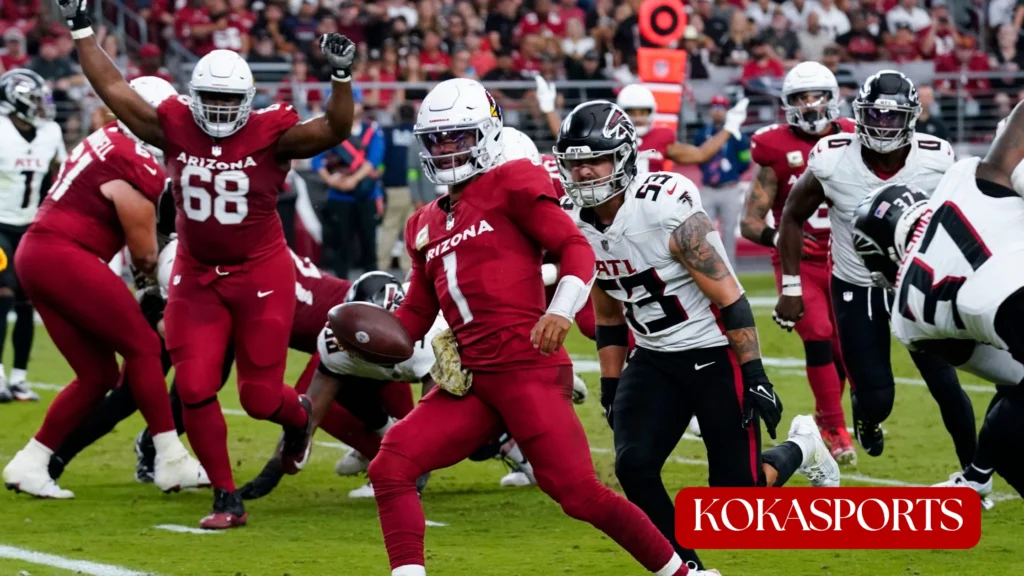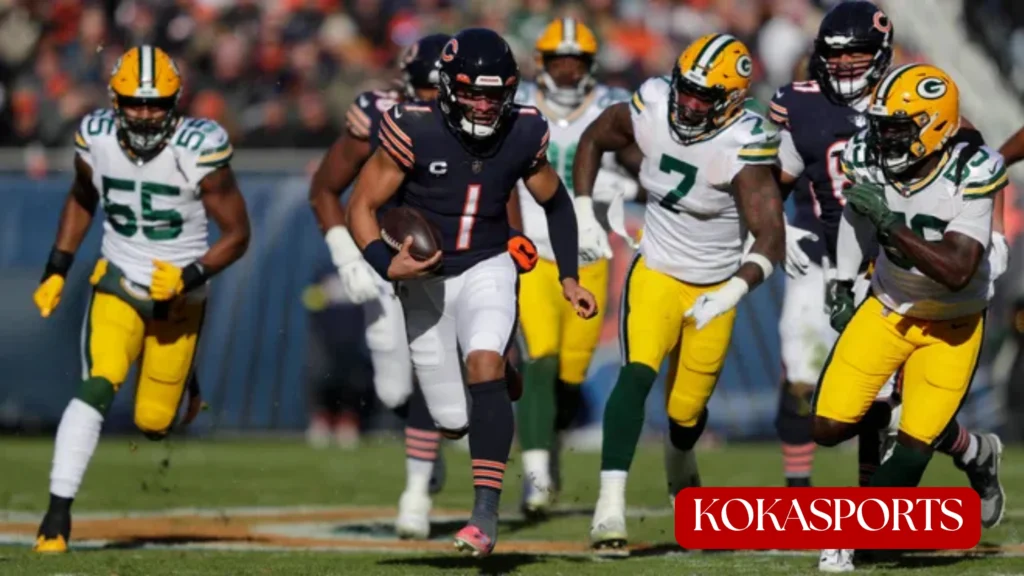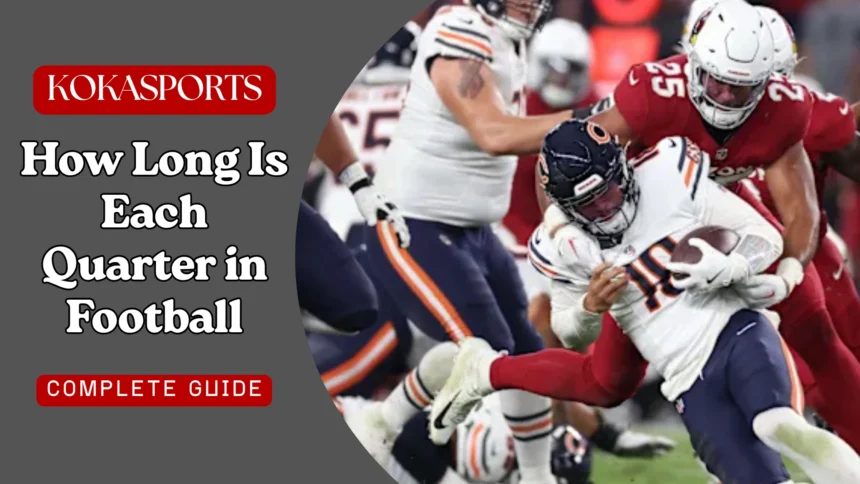When you sit down to watch a football game, you might notice something interesting: the clock shows 60 minutes of play, but you’re actually watching for over three hours. This raises an important question – how long is each quarter in football, and how does this work? The answer lies in how American football structures its games through a unique quarter system that affects everything from halftime breaks to the total length of a football game.
Football games are divided into four quarters, creating natural breaks that allow for strategic planning, rest periods, and the dramatic pacing that makes the sport so exciting. Whether you’re watching an NFL matchup, a college football showdown, or a local high school game, the quarter system remains the foundation of how the sport is played. However, the actual duration of each quarter varies depending on the level of play, and the real-time length extends far beyond what the game clock displays.
In this comprehensive guide, we’ll explore exactly how long each quarter lasts across different levels of American football, why a 60 minutes of game time contest takes several hours to complete, and what factors contribute to the total game length. From NFL football to youth leagues, we’ll break down everything you need to know about football timing and how long is each quarter in football at every level.
Basic Structure: How Long Is Each Quarter in Football

American football game structure is built around a system of four quarters that divide the contest into manageable segments. This format applies across nearly all levels of organized football, though the specific duration of each quarter changes based on whether you’re watching professionals, college athletes, or younger players.
At the NFL level, each quarter is 15 minutes long, creating four 15-minute quarters that total exactly 60 minutes of game time. The college football game follows the same pattern with four quarters of 15 minutes each. However, when we move to high school football, the structure shifts to 12-minute quarters, reducing the total clock time to 48 minutes. Youth football leagues typically use even shorter quarters, ranging from 8 to 10 minutes long, depending on the age group and specific football league rules.
Here’s a quick breakdown of quarter lengths:
- NFL and College Football: 15 minutes per quarter
- High School Football: 12 minutes per quarter
- Youth Football: 8-10 minutes per quarter
The game is divided into four quarters with a significant halftime break occurring after the second quarter. This structure creates two halves, each consisting of two quarters, which is why you’ll often hear commentators discuss “half of an NFL game” statistics and performance.
Read More: How Long Does Football Games Last?
NFL Game Quarters: The Professional Standard
An NFL game consists of four quarters, each lasting exactly 15 minutes. This means that nfl game features 60 minutes of game play on the official clock. However, if you’ve ever attended or watched an average NFL game, you know the actual time spent watching is significantly longer – typically around 3 hours and 12 minutes.
Why does this happen? The game clock doesn’t run continuously. Multiple factors stop the game clock throughout each quarter:
- Incomplete passes stop the clock until the next snap
- Timeouts – each team gets three timeouts per half
- Penalties that require discussion and yardage enforcement
- Instant replay reviews for controversial calls
- Scoring plays including touchdowns and field goal attempts
- Commercial breaks during televised games
- Two-minute warnings before each half ends
During an NFL contest, the first quarter might take 45 minutes in real-time despite showing only 15 minutes on the clock. The same applies to the third quarter and other periods. The average NFL game takes approximately hours and 12 minutes (3 hours and 12 minutes) from kickoff to the final whistle during the regular season.
NFL Halftime Break
Halftime in NFL games typically lasts 12 minutes, though this extends considerably for special events. The Super Bowl, for example, features a 30 minutes long halftime show with elaborate performances that have become cultural events in their own right. During regular season games, teams use this brief 12 minutes to make adjustments, rest, and prepare for the second half.
College Football: Similar Clock, Different Pace

A college football game follows the same basic timing as NFL contests – divided into four 15-minute quarters. However, the average college football game runs even longer than professional games, typically lasting around 3 hours and 24 minutes. Some college game contests can push close to four hours.
Several factors make college football games longer:
- Clock Stoppages After First Downs: The game clock is stopped after every first down until the ball is set, adding significant real time to each quarter.
- More Scoring Plays: College and high school games often feature higher-scoring offenses, meaning more clock stoppages for touchdowns and celebrations.
- Longer Halftime: The average college halftime lasts approximately 20 minutes, giving marching bands time to perform and teams more time to strategize.
- Replay Reviews: With advanced technology available, the length of a college football game increases due to frequent reviews of close plays.
- Different Clock Rules: NFL and college football handle clock management differently in the final minutes of each half, with college rules sometimes leading to longer game durations.
The game takes longer despite having the same minutes of game time because of these rule differences. Time spent on the field for players extends beyond what casual viewers might expect when they see a 15 minutes long quarter displayed.
High School and Youth Football: Shorter But Still Strategic
High school football games operate on a compressed timeline compared to professional and collegiate contests. The typical high school football game features four quarters of 12 minutes each, totaling 48 minutes of clock time. Despite this shorter duration, these games still embody the full standard football experience with all the strategic elements of higher levels.
The halftime break at high school and college games varies, but high school typically allows 10-15 minutes for bands to perform and teams to regroup. The entire game length for high school contests averages around 2 hours and 15 minutes in real time.
Youth football takes this reduction even further:
- Quarters range from 8-10 minutes depending on age group
- Total game time might be only 32-40 minutes on the clock
- Games typically last 1.5 to 2 hours in real time
- Halftime is usually 8-10 minutes
- Simplified rules reduce some clock stoppages
Even though the playing time is reduced, youth leagues maintain the four quarters structure to teach proper game time management and mirror the format players will encounter as they advance.
Why Does 60 Minutes Take Over Three Hours?

This question puzzles many new football game viewers. The disconnect between clock time and actual time results from how American football manages its game clock. Unlike sports with continuous play like soccer or basketball, football deliberately stops and starts the clock based on various game situations.
Every 15 minutes of play in an NFL game includes:
| Clock Stoppage Type | Approximate Time Added |
|---|---|
| Commercial Breaks | 45-60 minutes total |
| Timeouts (6 per half) | 15-20 minutes |
| Penalties & Reviews | 10-15 minutes |
| Halftime | 12-30 minutes |
| Between Quarter Breaks | 5-8 minutes |
| Injury Timeouts | Variable |
| Two-Minute Warnings | 4-6 minutes |
The game clock only runs during active playing time when the ball is in play. Between each play, teams huddle, line up, and execute their strategies while the clock may or may not be running depending on the outcome of the previous play. An incomplete pass, for instance, stops the clock completely.
Television broadcasts add another layer. NFL games include commercial breaks after scoring plays, at the two-minute warning, after timeouts, and during natural stoppages. These breaks add roughly 20 minutes per quarter in a televised NFL game, significantly extending what viewers experience.
Comparing Game Lengths Across Football Levels
To better visualize how football game duration varies across different levels, consider this comparison:
| Level | Quarter Length | Total Clock Time | Average Real Time | Halftime Duration |
|---|---|---|---|---|
| NFL | 15 minutes | 60 minutes | 3 hours 12 minutes | 12 minutes |
| College Football | 15 minutes | 60 minutes | 3 hours and 24 minutes | 20 minutes |
| High School Football | 12 minutes | 48 minutes | 2 hours 15 minutes | 10-15 minutes |
| Youth Football | 8-10 minutes | 32-40 minutes | 1 hour 30 minutes | 8-10 minutes |
The length of a football contest clearly depends on the level of competition. An average NFL game viewer commits to roughly three hours, while someone watching an average college football game should expect closer to three and a half hours. High school football games offer a more compact experience without sacrificing the essential elements of the sport.
Overtime: When The Game Goes Beyond Four Quarters
What happens when a game ends in a tie after four quarters of 15 or 12 minutes? The sport extends into overtime periods, adding even more time to the total game length.
NFL Overtime Rules
When an NFL contest ends in a tie after regulation, the league uses a modified sudden-death format:
- Regular season overtime consists of one 10-minute period
- If the game is still tied after that period, the game ends in a tie
- In playoff games, teams play continuous 15-minute periods until someone wins
- Both teams get possession opportunities under current rules
- A field goal on the first possession no longer ends the game automatically
College Football Overtime
College football uses a more dramatic system:
- Teams alternate possessions starting from the opponent’s 25-yard line
- Each team gets a chance to score
- Starting in the third overtime, teams must attempt two-point conversions instead of extra points
- This system often produces exciting high-scoring overtime periods
- Games can theoretically continue indefinitely until a winner emerges
High School Overtime
Most high school and college overtime rules align, with teams alternating possessions from the 25-yard line. State associations may modify these rules slightly, but the basic principle remains the same.
Overtime significantly extends game length. An NFL game with overtime might last 3.5 hours or more, while overtime college football games have exceeded four hours in rare cases.
The Role and Length of Halftime
Halftime serves multiple crucial purposes throughout the game. It provides players with essential rest after playing two quarters of intense football, allows coaching staffs to make adjustments based on first and third quarters performance, and gives fans entertainment and refreshment opportunities.
How long is halftime at different levels?
- NFL: 12 minutes (30+ minutes for Super Bowl)
- College Football: 20 minutes
- High School: 10-15 minutes
- Youth: 8-10 minutes
The long is halftime period directly impacts total game length. A longer halftime in college football contributes to why these games extend beyond NFL contests despite identical quarter lengths. The halftime break represents roughly one-sixth of the total real-time duration of most football game broadcasts.
Conclusion
American football uses a four quarters system that structures the entire flow and strategy of the sport. While the official clock shows 60 minutes (divided into four 15-minute quarters at NFL and college levels), the game is divided into distinct periods that create natural breaks for rest, planning, and broadcast needs.
The disconnect between minutes of play and actual time stems from how the sport manages its game clock. Stoppages for various reasons mean that every 15 minutes of play requires roughly 45 minutes of real time to complete. When you add halftime, commercial breaks, and potential overtime if the game is tied, you get the three-plus hour experience familiar to all football game fans.
Whether you’re settling in to watch an NFL game, supporting your local high school football team, or introducing children to the sport through youth football, you now know exactly what to expect in terms of game length. The four quarters of 15 minutes (or less at lower levels) create a framework that balances athletic competition with strategic depth, making American football one of the most engaging sports to follow despite – or perhaps because of – its extended duration.
FAQs
How long is a quarter of a football game?
NFL and college quarters are 15 minutes long, high school quarters are 12 minutes, and youth football quarters range from 8-10 minutes.
How long is football halftime?
NFL halftime is 12 minutes (30+ for Super Bowl), college is 20 minutes, high school is 10-15 minutes, and youth is 8-10 minutes.
Is a touchdown 6 or 7 points?
A touchdown is worth 6 points, but teams can add 1 point with an extra-point kick or 2 points with a conversion play, making it potentially 7 or 8 points total.
Is football played in 3 or 4 quarters?
Football is played in 4 quarters at all levels of American football.
How long is a football game in total?
NFL games last about 3 hours, college football around 3.5 hours, high school games 2-2.5 hours, and youth games 1.5-2 hours.
How many quarters are in a football game?
All American football games have four quarters, though the length of each quarter varies by level.
Are all football games divided into four quarters?
Yes, all football games use a four-quarter format as the standard structure.
Why do football games take so long?
The game clock stops frequently for incomplete passes, timeouts, penalties, reviews, and commercials, extending 60 minutes of game time to over 3 hours.
What is the total game time in professional football?
NFL games have 60 minutes of clock time (four 15-minute quarters) but take about 3 hours and 12 minutes in real time.
How long is a college football game compared to the NFL?
College football games average 3 hours and 24 minutes, slightly longer than NFL games due to different clock rules and longer halftime.




